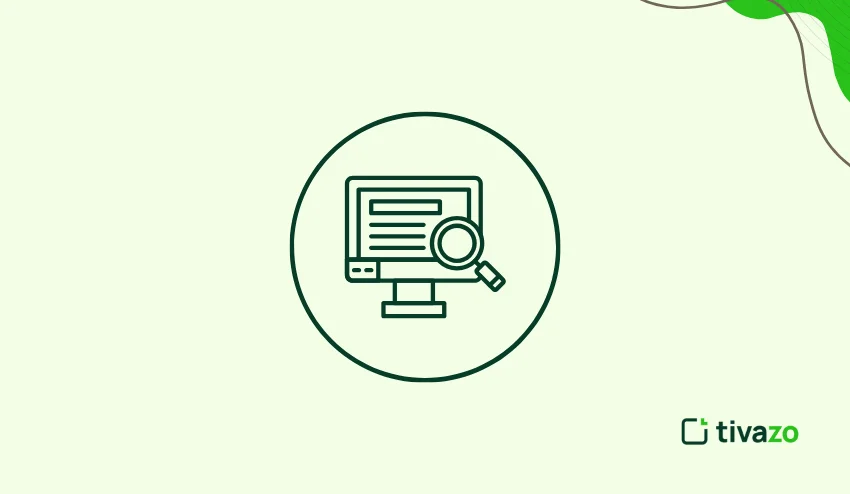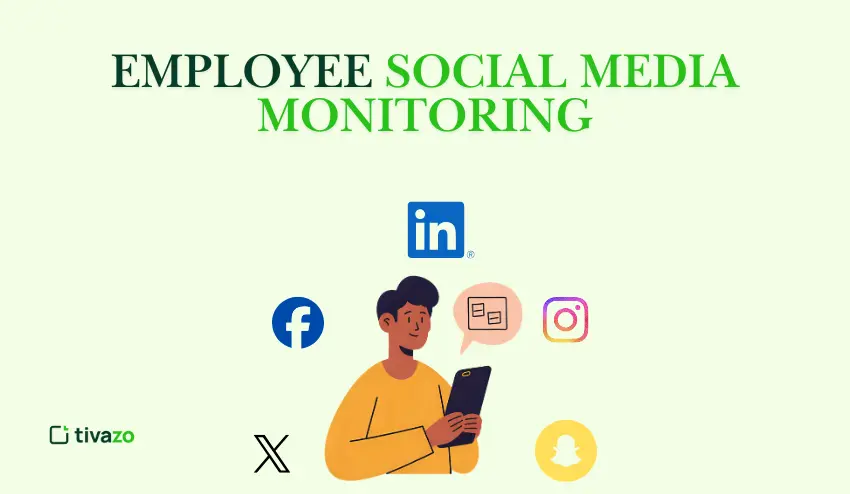Call center monitoring is more than listening to calls — it provides visibility into how your business communicates, solves problems, and delivers value to customers. With the right monitoring systems, businesses can look beneath the surface of customer interactions to reveal hidden patterns, identify areas for improvement in agent performance, and actively manage quality. Call center monitoring is also important for businesses that must comply with regulations that require agents to read scripts and protect consumers’ data privacy. If your business operates in finance, healthcare, or telecommunications, that imperative is non‑negotiable.
Call center monitoring today embraces more powerful technologies, like speech analytics, AI-based sentiment detection, and tools to coach agents in real-time. Almost every customer interaction can be analyzed at scale — not just 1% of calls — to provide an accurate assessment of agent performance and customer sentiment. Whether you are managing an internal team or partnering with a BPO partner, having call center monitoring capability in place is essential to ensure your voice of the brand remains consistent, agents stay engaged, and customers are satisfied. In a nutshell, we believe call center monitoring is table stakes for any organization that seeks to improve customer experiences.
Key Highlights:
- What is Call Center Monitoring?
- The importance of call center monitoring
- Types of Call Center Monitoring
- How to monitor your call center performance
- Call Center Monitoring – Key Metrics
- What is the 80/20 rule in a Call Center?
What is Call Center Monitoring?
Call center monitoring provides an important continuity of a consistent and quality experience across all channels of interaction. Monitoring is crucial because it helps ensure that agents are following procedures, providing accurate information, and using appropriate language and empathy. In order to monitor calls and other forms of communications, there is no substitute for monitoring them live or after the fact. A supervisor can gain insights into performance trends, customer expectations, or issues that need further review.
In an era of customer expectations for fast, personal, and issue-free service, organizations can better position themselves to meet expectations through the use of call center monitoring. Here are some of the ways it enables that.
1. Identify barriers before they get too far
Monitoring allows organizations to identify barriers or pain points early.
For example, if multiple calls uncover confusion over a particular policy or product, organizations can
- Update customer-facing messaging
- Revise internal training material
- Escalate to the appropriate internal department for review
2. Spotlight and replicate agent success
Monitoring isn’t just a tool for detecting agent mistakes. It also allows organizations to:
- Spot and acknowledge their top agents
- Identify successful communication styles and practices, to make them available to the rest of the team as a learning tool
- Fairly provide individuals with a motivation factor to maintain and increase team role standards
3. Provide the potential for accountability
With the increase of hybrid and remote, monitoring systems provide
- Transparency into an agent’s role contribution
- Coaching opportunities for supervisors without the need to wade through the masses.
- Autonomous agents with supervisor accountability to maintain quality.
4. Support development and growth
In conjunction with structured delivery of feedback and coaching, call center monitoring becomes a robust tool that:
- Implements quality assurance tools for call center processes.
- Creates opportunities for agent growth and development as an individual.
- Facilitates long-term growth for both customer satisfaction and operational excellence.
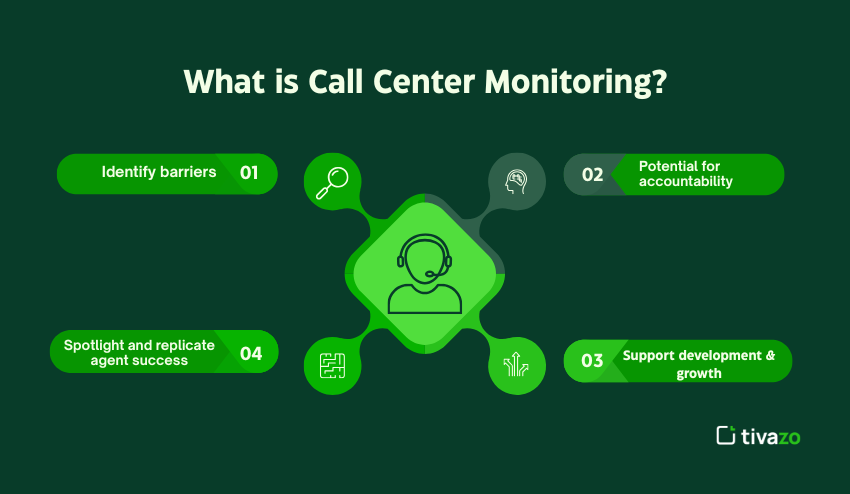
The importance of call center monitoring
1. Improve agent performance
Call center monitoring enables identification of coaching opportunities, adherence to the script, empathy shortfalls, and upselling success through analysis of calls ‐ manually or automatically
2. Improve customer satisfaction
Call center monitoring allows for the discovery of potential bottlenecks and trends in namesakes or sentiment so that you can provide remediation before customers leave. This relates to customer-centric metrics such as CSAT / NPS.
3. Monitor quality and compliance
Continuous call center monitoring supports adherence to script, legal obligations (e.g.
disclaimers), and organizational policies. Call center monitoring also builds auditability and compliance scorecards.
4. Optimize operations
Call center monitoring offers access to data that can expose peak times, transfer rates, AHT, abandonment rates, and resource deployment for service, which will lead to improved operational effectiveness.
5. Improve ROI
In conjunction with training and providing insights, call center monitoring can significantly improve churn, reduce cost‐to‐serve, and increase upsell success.
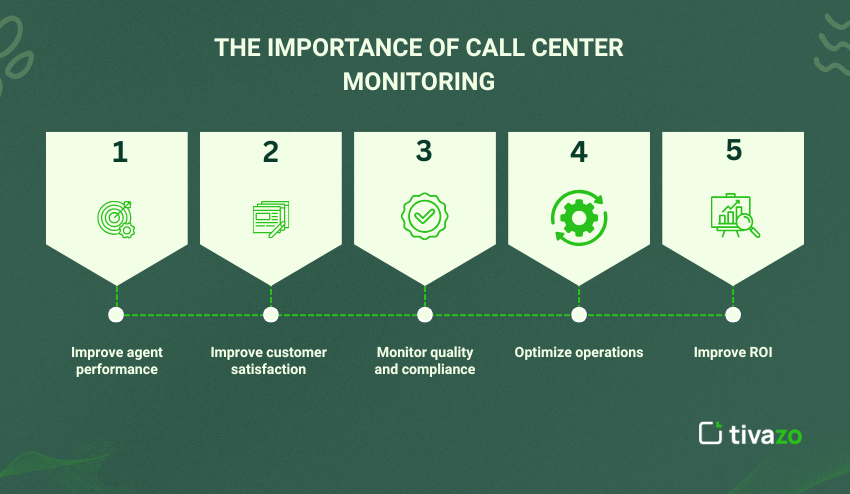
Types of Call Center Monitoring
Each of these provides a distinct function for both service delivery quality and agent performance
1. Manual Monitoring
Although manual monitoring is high effort, the overall benefit is that it offers a contextual analysis so that a reviewer can evaluate the agent’s tone, empathy, and skills that they may have missed by automation.
But since typically small percentages of calls are sampled, this tracking direction can miss larger learnings about systemic problems in processes unless they are complemented with monitoring for the aggregate.
2. Live Monitoring / Live Listening
Live monitoring is very useful for immediate and on-the-spot intervention, especially when there is a potential for an escalated call. For example, a supervisor may enter “whisper mode” to guide an agent during a call without the customer hearing it. Another option is called “barge-in,” where a supervisor can take over the call if necessary. Live monitoring is good for onboarding or performance reviews.
3. Automated and AI / Speech analytics Monitoring
Automated and AI/Speech analytics for monitoring are the most productive, efficient, and scalable options as they provide 100% call coverage. Most of today’s call center platforms offer not only keyword and phrase metrics, but also general sentiment, emotions, while also tracking compliance. The AI automates the majority of the tracking and provides the supervisors with automatic dashboards of all their team members’ performance, with alerts if there is any risk. This monitoring is the best solution for supervisory coaching at scale while maintaining some level of quality in quality across large, dispersed teams.
How to monitor your call center performance
Call center monitoring can happen in these phases:
Step 1: Identify goals & evaluation criteria
Set objectives that are clear: compliance, improve CSAT, reduce AHT. Then specify scoring rubrics, key phrases, and compliance checks.
Step 2: Capture and record interactions
Record all calls with call recording software. You can also choose to transcribe them so that detailed text/speech analysis is possible
Step 3: Analyze with speech analytics & AI
Uncover sentiment, intent, emotions, and your compliance issues. Use a tool that tracks real-time cues and risks, and can flag where training is needed
Step 4: Review manually or by sampling
While automation is wonderful, you have to have QA panels of actual humans, not robots, to calibrate and validate scores. Review all edge-cases and risky calls.
Step 5: Give feedback & coaching
Use the information from call center monitoring to derive targeted agent coaching, give a plan, and follow up on the plan
Step 6: Monitor metrics and trends over time
Monitor center-level KPIs like First Call Resolution, AHT, internal transfer rates, and bandoned call rates. And adjust your operation accordingly
Step 7: Continually refine
Leverage your call center monitoring to update your scoring criteria, scripts, self-service, and training materials.
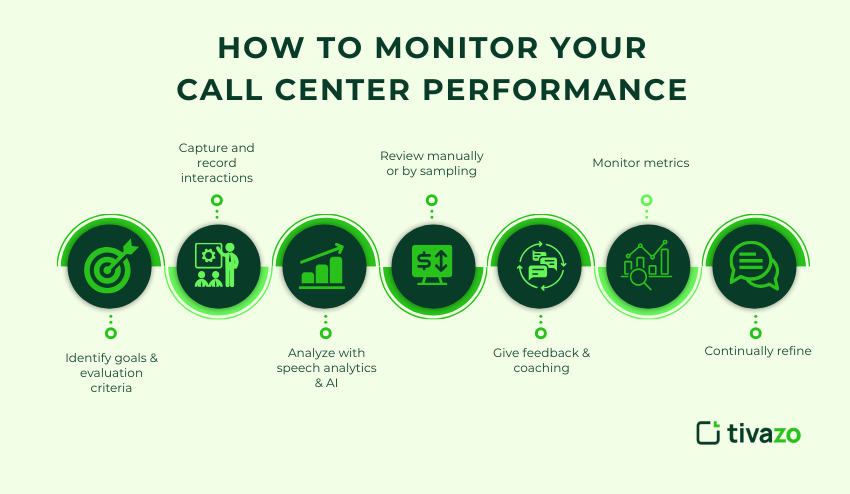
Call Center Monitoring – Key Metrics
| Metric | Metric Description | Why is this important? |
| First Call Resolution (FCR) | % of calls resolved at initial contact | High FCR means high customer satisfaction |
| Average Handle Time (AHT) | Total talk time + hold time + after-call time per call | Shorter AHT can be associated with improved efficiency |
| Transfer Rate % | Calls transferred between agents | An unacceptable number of transfers hurts the overall customer experience |
| Abandonment Call Rate | % of calls dropped before being answered | High abandonment rate mirrors the understaffing/abandonment factor of the call |
| Customer Satisfaction (CSAT) | Survey-based rating after call | Quality indicator of cx |
| Agent Sentiment Score | AI-derived emotional and/or tone | Score Concern for empathy & professionalism |
| Compliance Score | % of compliance with legal standard and/or script adherence | Avoids fines/protects brand |
Providing organizations with the ability to analyze these metrics through call center monitoring enables organizations to make data-driven decisions that are positive for customer experience & operational efficiency. Organizations are able to identify trends in agent behaviors, the flow of the call, and customer sentiment, which enables organizations to continuously improve their support processes, adjust and improve training programs, and maintain high levels of quality and compliance.
What is the 80/20 rule in a Call Center?
Expanding on the 80/20 rule in call centers makes clear how powerful this concept can be when strategically applied through call center monitoring.
Most call centers will have a small number of repeating issues, customer complaints, or agent behaviors that drive the majority of negative results, such as excessive call times, low satisfaction scores, or poor rates of resolution. With regular monitoring, those negative trends become clear. An example is a script that confuses customers or a broken feature in a product. This will be an issue mentioned by 20% of customers, but could generate near-80% of the dissatisfaction. Once you can find and fix those root cause issues, it has an astounding impact on how the call center performs overall.
Call center monitoring solutions using AI, call monitoring, and speech analytics can automatically surface patterns such as:
- Words or phrases used repeatedly relating to the same issue
- Specific agents with the highest AHT on calls
- Recurring escalation triggers or repeated misstatements of policy
Once identified, the business can take an informed action such as
- Rewrite the script or clarify the meaning of the phrases
- Provide additional coaching to the respective agent in question
- Update self-service material or FAQs to reduce call volume
Furthermore, leveraging the 80/20 Principle drives smarter resource allocation. Rather than equally spreading QA effort across all interactions, teams can start to devote more time and focus on the calls and behaviors that will have the largest impact. Ultimately, doing this will not only drive efficiency but will also reduce resolution times and enhance customer loyalty.
In the end, utilizing call center monitoring to help apply the 80/20 rule improves overwhelming amounts of data into actionable strategies to improve the customer journey as well as to improve internal processes.
Here are the five best call center monitoring tools.
Below is a curated list of proven tools, and it includes Tivazo integration options:
1. Qualtrics Contact Center Quality Management – best for full-scale call center monitoring with AI scoring and real-time insight
2. Zoom Contact Center / Voice Analytics – provides call monitoring, voice & speech analytics, compliance tracking, and live whisper and barge
3. Tivazo – especially if you have it integrated with your PBX or contact center platform: live call monitoring roles (listen, whisper, barge), call recording, and a great add-on for compliance and quality monitoring.
4. Speech Analytics platforms (NICE, Verint, Invoca) – powerful for monitoring sentiment and intent in automated reports, can analyze massive amounts of data.
5. Workforce Engagement / WFM suites (NICE WFM, Genesys WFM) – built-in call center monitoring integrated with scheduling, compliance monitoring, and scoring dashboards.
Job Types & Careers in Monitoring a Call Center
Monitoring is often accomplished by:
- Quality Assurance (QA) Analysts or Specialists – listen to a sample of calls on a call type, and score the calls according to a rubric.
- Call Center Supervisors or Team Leads – do live monitoring: listen, whisper, or barge in as needed.
- Contact Center Managers – will monitor trends, compliance, and coach on a team-wide basis.
- Speech Analytics / Data Analysts – review AI scoring dashboards to get insights.
- Workforce Managers / WFM Analysts – will use monitoring metrics for planning staffing.
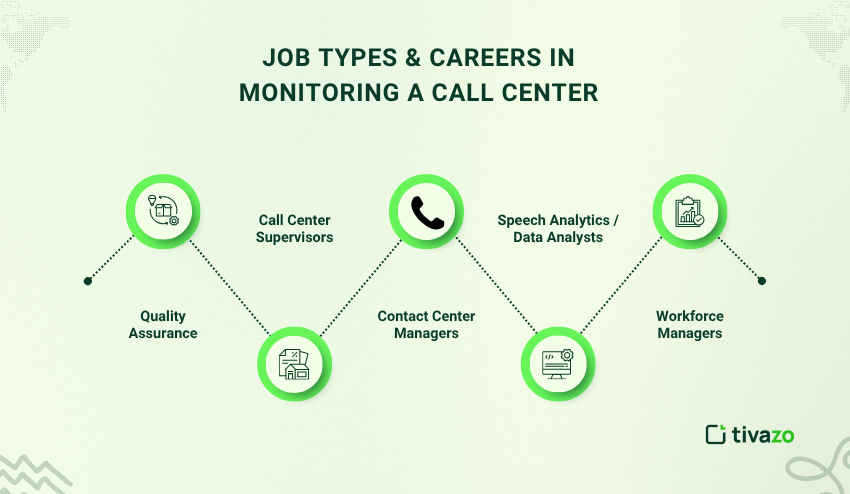
Conclusion
In today’s fast-paced, customer-first world, call center monitoring is no longer a “nice to have”—it has become a “must have.” Monitoring can take many shapes and forms, from manual reviews of calls to artificial intelligence and analytics. Monitoring gives brands the ability to identify issues, reward top agents, ensure compliance, and provide continuous improvement to customer experiences. By implementing an organized call center monitoring methodology, organizations can glean deeper insights into the behavior of customers and performance of agents (while identifying growth opportunities) to help them make smarter decisions with data.
Whether it’s increasing your First Call Resolution rate, reducing handling time, or increasing customer satisfaction, monitoring will help get you to the destination faster and with more accuracy. Tools like Tivazo, Zoom, and Qualtrics can enhance your monitoring, giving you real-time visibility & actionable feedback. At the end of the day, call center monitoring is more than just a quality assurance initiative—it is the foundation of your customer service strategy, done correctly. Start small, continuously work at it, and employ the 80/20 principle—you will go from a maximum effort to maximum output of your monitoring. Your customers—and your bottom line—will be glad you did.


